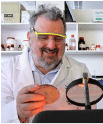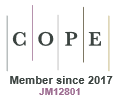Rumen microbiome response to methane inhibition
Ibrahim Ahmad A * , Richard P. Rawnsley A , John P. Bowman A and Apeh A. Omede AA

Ibrahim Ahmad is a veterinarian and a PhD candidate at the Tasmanian Institute of Agriculture (TIA), University of Tasmania. He has several years of experience in general veterinary practice, meat inspection and research. His research interests include mitigation of enteric methane emissions from grass-fed dairy and beef production systems, rumen microbiology, animal nutrition and livestock systems modelling. |

Assoc. Prof. Richard Rawnsley is the academic lead for the Livestock Production Centre within the TIA. His research focuses on developing practical, science-based solutions to enhance both animal performance and the sustainability of pasture-based livestock systems. |

Prof. John P. Bowman is a microbiologist based in Launceston, Tas., where he is the professor of microbiology at the University of Tasmania. He is the leader of the Centre for Food Safety and Innovation within the Tasmanian Institute of Agriculture. His interests are broad and cover many aspects of food and agricultural systems, microbial ecology and systematics. He is a Fellow of the Australian Society of Microbiology. He completed his PhD (and DSc) at The University of Queensland and has been a researcher and lecturer at the University of Tasmania since the mid-1990s. |

Dr Apeh A. Omede is a lecturer and researcher in animal production at the TIA, University of Tasmania. He is interested in researching the interphase between nutritional strategies for sustainable animal production, the environment and gut microbiome in farm animals. He was a Marie Curie COFUND postdoc at Teagasc Ireland before joining the University of Tasmania. |
Abstract
Rumen microbiota ferment feed into various by-products, some of which are used by methanogens to produce enteric methane (CH4), a potent greenhouse gas (GHG) that significantly contributes to climate change. The use of CH4 inhibitors, such as Asparagopsis spp. and 3-nitrooxypropanol (3-NOP), in ruminant feed has been shown to be effective in reducing methanogenesis. However, inhibition of enteric CH4 leads to inconsistent productivity gains, partly due to the shift in significant fermentative microbes away from acetogenesis and the inability to convert increased ruminal dihydrogen (H2) spared from methanogenesis into absorbable nutrients beneficial to the host animals. Mitigation of CH4 synthesis paired with redirection of ruminal H2 to preserve normal rumen functions could be one of the most promising strategies to improve ruminant productivity while feeding CH4 inhibitors. This review highlights the growing knowledge of the rumen microbiome response to CH4 inhibition and explores the potential benefits of co-supplementing CH4 inhibitors with electron acceptors to optimise rumen function as a future direction to supporting the voluntary on-farm adoption of anti-methanogenic feed additives (AMFAs) across livestock systems.
Keywords: 3-NOP, Asparagopsis, feed additive, greenhouse gas, methane emission, methane inhibition, methanogenesis, rumen fermentation, rumen microbiome, ruminants.
 Ibrahim Ahmad is a veterinarian and a PhD candidate at the Tasmanian Institute of Agriculture (TIA), University of Tasmania. He has several years of experience in general veterinary practice, meat inspection and research. His research interests include mitigation of enteric methane emissions from grass-fed dairy and beef production systems, rumen microbiology, animal nutrition and livestock systems modelling. |
 Assoc. Prof. Richard Rawnsley is the academic lead for the Livestock Production Centre within the TIA. His research focuses on developing practical, science-based solutions to enhance both animal performance and the sustainability of pasture-based livestock systems. |
 Prof. John P. Bowman is a microbiologist based in Launceston, Tas., where he is the professor of microbiology at the University of Tasmania. He is the leader of the Centre for Food Safety and Innovation within the Tasmanian Institute of Agriculture. His interests are broad and cover many aspects of food and agricultural systems, microbial ecology and systematics. He is a Fellow of the Australian Society of Microbiology. He completed his PhD (and DSc) at The University of Queensland and has been a researcher and lecturer at the University of Tasmania since the mid-1990s. |
 Dr Apeh A. Omede is a lecturer and researcher in animal production at the TIA, University of Tasmania. He is interested in researching the interphase between nutritional strategies for sustainable animal production, the environment and gut microbiome in farm animals. He was a Marie Curie COFUND postdoc at Teagasc Ireland before joining the University of Tasmania. |
References
1 Mizrahi I et al. (2021) The rumen microbiome: balancing food security and environmental impacts. Nat Rev Microbiol 19, 553-566.
| Crossref | Google Scholar | PubMed |
2 Tapio I et al. (2017) The ruminal microbiome associated with methane emissions from ruminant livestock. J Anim Sci Biotechnol 8, 7.
| Crossref | Google Scholar | PubMed |
3 Morgavi DP et al. (2010) Microbial ecosystem and methanogenesis in ruminants. Animal 4, 1024-1036.
| Crossref | Google Scholar | PubMed |
4 Ungerfeld EM (2020) Metabolic hydrogen flows in rumen fermentation: principles and possibilities of interventions. Front Microbiol 11, 589.
| Crossref | Google Scholar | PubMed |
5 McAllister TA et al. (2025) International symposium on ruminant physiology: rumen fungi, archaea and their interactions. J Dairy Sci [Published online early 15 January 2025].
| Crossref | Google Scholar | PubMed |
6 Romero P et al. (2023) Rumen microbial degradation of bromoform from red seaweed (Asparagopsis taxiformis) and the impact on rumen fermentation and methanogenic archaea. J Anim Sci Biotechnol 14, 133.
| Crossref | Google Scholar | PubMed |
7 Belanche A et al. (2025) Feed additives for methane mitigation: a guideline to uncover the mode of action of antimethanogenic feed additives for ruminants. J Dairy Sci 108, 375-394.
| Crossref | Google Scholar | PubMed |
8 Hristov AN et al. (2013) Special topics — Mitigation of methane and nitrous oxide emissions from animal operations: I. A review of enteric methane mitigation options. J Anim Sci 91, 5045-5069.
| Crossref | Google Scholar | PubMed |
9 van Gastelen S et al. (2024) Long-term effects of 3-nitrooxypropanol on methane emission and milk production characteristics in Holstein–Friesian dairy cows. J Dairy Sci 107, 5556-5573.
| Crossref | Google Scholar | PubMed |
10 Machado L et al. (2016) Identification of bioactives from the red seaweed Asparagopsis taxiformis that promote antimethanogenic activity in vitro. J Appl Phycol 28, 3117-3126.
| Crossref | Google Scholar |
11 Glasson CRK et al. (2022) Benefits and risks of including the bromoform containing seaweed Asparagopsis in feed for the reduction of methane production from ruminants. Algal Res 64, 102673.
| Crossref | Google Scholar |
12 Dijkstra J et al. (2018) Short communication: Antimethanogenic effects of 3-nitrooxypropanol depend on supplementation dose, dietary fiber content, and cattle type. J Dairy Sci 101, 9041-9047.
| Crossref | Google Scholar | PubMed |
13 Duin EC et al. (2016) Mode of action uncovered for the specific reduction of methane emissions from ruminants by the small molecule 3-nitrooxypropanol. Proc Natl Acad Sci USA 113, 6172-6177.
| Crossref | Google Scholar | PubMed |
14 Pitta D et al. (2022) Symposium review: Understanding the role of the rumen microbiome in enteric methane mitigation and productivity in dairy cows. J Dairy Sci 105, 8569-8585.
| Crossref | Google Scholar | PubMed |
15 Majak W, Clark LJ (1980) Metabolism of aliphatic nitro compounds in bovine rumen fluid. Can J Anim Sci 60, 319-325.
| Crossref | Google Scholar |
16 Roque BM et al. (2019) Inclusion of Asparagopsis armata in lactating dairy cows’ diet reduces enteric methane emission by over 50 percent. J Clean Prod 234, 132-138.
| Crossref | Google Scholar |
17 Cowley FC et al. (2024) Bioactive metabolites of Asparagopsis stabilized in canola oil completely suppress methane emissions in beef cattle fed a feedlot diet. J Anim Sci 102, skae109.
| Crossref | Google Scholar | PubMed |
18 Hristov AN et al. (2015) An inhibitor persistently decreased enteric methane emission from dairy cows with no negative effect on milk production. Proc Natl Acad Sci USA 112, 10663-10668.
| Crossref | Google Scholar | PubMed |
19 Vyas D et al. (2016) Effects of sustained reduction of enteric methane emissions with dietary supplementation of 3-nitrooxypropanol on growth performance of growing and finishing beef cattle1. J Anim Sci 94, 2024-2034.
| Crossref | Google Scholar | PubMed |
20 Durmic Z et al. (2025) Feed additives for methane mitigation: recommendations for identification and selection of bioactive compounds to develop antimethanogenic feed additives. J Dairy Sci 108, 302-321.
| Crossref | Google Scholar | PubMed |
21 Ni G et al. (2024) Methanogenesis inhibition remodels microbial fermentation and stimulates acetogenesis in ruminants. bioRxiv 2024, 2024.08.15.608071 [Preprint, published 15 August 2024].
| Crossref | Google Scholar |
22 Krizsan SJ et al. (2023) Effects on rumen microbiome and milk quality of dairy cows fed a grass silage-based diet supplemented with the macroalga Asparagopsis taxiformis. Front Anim Sci 4, 1112969.
| Crossref | Google Scholar |
23 Zhang P et al. (2024) Red seaweed supplementation suppresses methanogenesis in the rumen, revealing potentially advantageous traits among hydrogenotrophic bacteria. bioRxiv 2024, 2024.06.07.597961 [Preprint, published 7 June 2024].
| Crossref | Google Scholar |
24 Khairunisa BH et al. (2023) Evolving understanding of rumen methanogen ecophysiology. Front Microbiol 14, 1296008.
| Crossref | Google Scholar | PubMed |
25 Gruninger RJ et al. (2022) Application of 3-nitrooxypropanol and canola oil to mitigate enteric methane emissions of beef cattle results in distinctly different effects on the rumen microbial community. Anim Microbiome 4, 35.
| Crossref | Google Scholar | PubMed |
26 Li X et al. (2018) Asparagopsis taxiformis decreases enteric methane production from sheep. Anim Prod Sci 58, 681.
| Crossref | Google Scholar |
27 Muizelaar W et al. (2021) Safety and transfer study: transfer of bromoform present in Asparagopsis taxiformis to milk and urine of lactating dairy cows. Foods 10, 584.
| Crossref | Google Scholar | PubMed |
28 Condie LW et al. (1983) Comparative renal and hepatotoxicity of halomethanes: bromodichloromethane, bromoform, chloroform, dibromochloromethane and methylene chloride. Drug Chem Toxicol 6, 563-578.
| Crossref | Google Scholar | PubMed |
29 Greening C et al. (2019) Diverse hydrogen production and consumption pathways influence methane production in ruminants. ISME J 13, 2617-2632.
| Crossref | Google Scholar | PubMed |
30 Romero P et al. (2023) Evaluating the effect of phenolic compounds as hydrogen acceptors when ruminal methanogenesis is inhibited in vitro – part 2. Dairy goats. Animal 17, 100789.
| Crossref | Google Scholar | PubMed |
31 Tsai CG, Jones GA (1975) Isolation and identification of rumen bacteria capable of anaerobic phloroglucinol degradation. Can J Microbiol 21, 794-801.
| Crossref | Google Scholar | PubMed |


